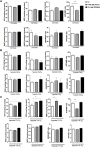Blocking cholesterol formation and turnover improves cellular and mitochondria function in murine heart microvascular endothelial cells and cardiomyocytes
- PMID: 37745244
- PMCID: PMC10512729
- DOI: 10.3389/fphys.2023.1216267
Blocking cholesterol formation and turnover improves cellular and mitochondria function in murine heart microvascular endothelial cells and cardiomyocytes
Abstract
Background: Statins and proprotein convertase subtilisin/kexin type 9 inhibitors (PCSK9i) are cornerstones of therapy to prevent cardiovascular disease, acting by lowering lipid concentrations and only partially identified pleiotropic effects. This study aimed to analyze impacts of atorvastatin and synthetic peptide PCSK9i on bioenergetics and function of microvascular endothelial cells and cardiomyocytes. Methods: Mitochondrial function and abundance as well as intracellular nucleotides, membrane potential, cytoskeleton structure, and cell proliferation rate were evaluated in mouse heart microvascular endothelial cells (H5V) and cardiomyocytes (HL-1) under normal and hypoxia-mimicking conditions (CoCl2 exposure). Results: In normal conditions PCSK9i, unlike atorvastatin, enhanced mitochondrial respiratory parameters, increased nucleotide levels, prevented actin cytoskeleton disturbances and stimulated endothelial cell proliferation. Under hypoxia-mimicking conditions both atorvastatin and PCSK9i improved the mitochondrial respiration and membrane potential in both cell types. Conclusion: This study demonstrated that both treatments benefited the endothelial cell and cardiomyocyte bioenergetics, but the effects of PCSK9i were superior.
Keywords: cardiomyocytes; endothelial cells; mitochondria; proprotein convertase subtilisin/kexin type 9 (PCSK9) inhibitor; statins.
Copyright © 2023 Braczko, Harasim, Kawecka, Walczak, Kapusta, Narajczyk, Stawarska, Smoleński and Kutryb-Zając.
Conflict of interest statement
The authors declare that the research was conducted in the absence of any commercial or financial relationships that could be construed as a potential conflict of interest.
Figures









Similar articles
-
Chronic PCSK9 inhibitor therapy leads to sustained improvements in endothelial function, arterial stiffness, and microvascular function.Microvasc Res. 2023 Jul;148:104513. doi: 10.1016/j.mvr.2023.104513. Epub 2023 Mar 3. Microvasc Res. 2023. PMID: 36870561
-
The Effect of Proprotein Convertase Subtilisin Kexin Type 9 Inhibitors on Circulating Endothelial Progenitor Cells in Patients with Cardiovascular Disease.Cardiovasc Drugs Ther. 2022 Feb;36(1):85-92. doi: 10.1007/s10557-020-07119-1. Epub 2021 Jan 4. Cardiovasc Drugs Ther. 2022. PMID: 33394363
-
Lipoprotein Apheresis and Proprotein Convertase Subtilisin/Kexin Type 9 Inhibitors in Patients With Heterozygous Familial Hypercholesterolemia: A One Center Study.J Cardiovasc Pharmacol Ther. 2021 Jan;26(1):51-58. doi: 10.1177/1074248420943079. Epub 2020 Jul 30. J Cardiovasc Pharmacol Ther. 2021. PMID: 32729335
-
Proprotein convertase subtilisin/kexin type 9 (PCSK9) inhibitors: Present perspectives and future horizons.Nutr Metab Cardiovasc Dis. 2016 Oct;26(10):853-62. doi: 10.1016/j.numecd.2016.05.006. Epub 2016 May 30. Nutr Metab Cardiovasc Dis. 2016. PMID: 27352986 Review.
-
Statins and PCSK9 inhibitors: A new lipid-lowering therapy.Eur J Pharmacol. 2020 Jul 5;878:173114. doi: 10.1016/j.ejphar.2020.173114. Epub 2020 Apr 14. Eur J Pharmacol. 2020. PMID: 32302598 Review.
Cited by
-
Safety and Efficacy of Achieving Very Low LDL Cholesterol Concentrations with PCSK9 Inhibitors.J Clin Med. 2025 Jun 27;14(13):4562. doi: 10.3390/jcm14134562. J Clin Med. 2025. PMID: 40648946 Free PMC article. Review.
-
PCSK9 Enhances Cardiac Fibrogenesis via the Activation of Toll-like Receptor and NLRP3 Inflammasome Signaling.Int J Mol Sci. 2025 Feb 23;26(5):1921. doi: 10.3390/ijms26051921. Int J Mol Sci. 2025. PMID: 40076547 Free PMC article.
-
Mitochondrial cholesterol metabolism related gene model predicts prognosis and treatment response in hepatocellular carcinoma.Transl Cancer Res. 2024 Dec 31;13(12):6623-6644. doi: 10.21037/tcr-24-1153. Epub 2024 Dec 27. Transl Cancer Res. 2024. PMID: 39816559 Free PMC article.
References
-
- Bouitbir J., Charles A. L., Echaniz-Laguna A., Kindo M., Daussin F., Auwerx J., et al. (2012). Opposite effects of statins on mitochondria of cardiac and skeletal muscles: A “mitohormesis” mechanism involving reactive oxygen species and PGC-1. Eur. Heart J. 33, 1397–1407. 10.1093/EURHEARTJ/EHR224 - DOI - PMC - PubMed
LinkOut - more resources
Full Text Sources
Miscellaneous

